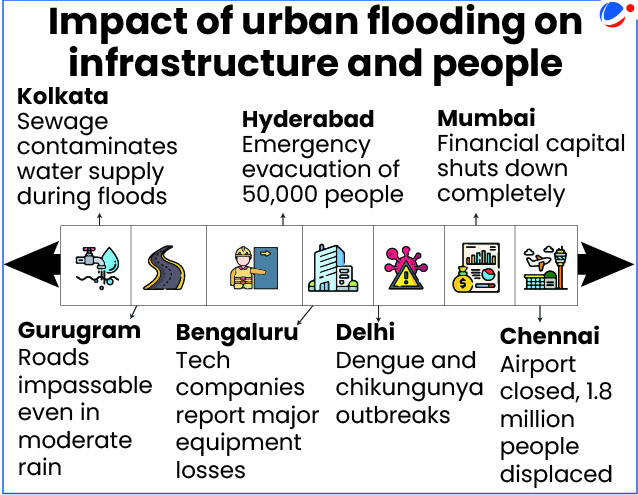
Why in the News?
Recently, heavy pre-monsoon thundershowers in Bengaluru for a short period of time led to severe Floods.
More on the News
- Similar incidents of Flooding in major cities like Hyderabad (2020-21), Chennai (2021), Bengaluru and Ahmedabad (2022), Delhi (2023), shows that Urban Flooding has become a regular phenomenon.
What is Urban Flooding?
- It is a type of flood, where a city or Urban Area is inundated with water often due to inability of drainage systems to handle sudden, excessive rainfall.
- Urban flooding differs from rural flooding as cities have more developed land, which can increase flood peaks by 1.8 to 8 times and flood volumes by up to 6 times.
Causes of Urban Flooding
Natural Factors

- Meteorological Factors: Extreme precipitation events cause sudden water accumulation, as seen in 2005 Mumbai Floods and 2015 Chennai Floods. Similarly storm surges and rapid snowmelt create additional flooding risks, as seen in Sikkim floods of 2023.
- Climate change has intensified these patterns, As the IPCC has warned about increasing monsoon pattern across south Asia, our major cities remain constantly at risk.
- Hydrological Factors: Flood risk arises when the surface runoff is more than the infiltration rate during precipitation, this leads to overbank flow channel networks.
- Heavy rainfall in the catchment area of the Yamuna results into overflow of the Yamuna River, which leads to flooding in Delhi.
Anthropogenic factors
- Unplanned Urbanization: For instance, Bengaluru's drains are designed only for rainwater but forced to handle around 2000 MLD of sewage daily.
- Further, builders routinely encroach upon or eliminate drains by reducing widths or converting them to roads, while existing drains become choked with garbage and silt.
- Lake Encroachments: As more people migrate towards cities in search of employment, people start settling on the ownerless available vacant land i.e. Low-lying areas near water bodies. Sometimes these encroachments cover up the whole catchment area.
- Example: Ousteri Lake in Puducherry, Charkop Lake in Maharashtra, Pallavaram marshlands in Chennai.
- Unplanned release of water from dams: Unplanned and sudden release of water from dams and lakes lead to floods in an urban area, without giving the public enough time to respond.
- Example: Chennai Floods 2015 due to Release of water from Chembarampakkam lake, Pune Floods due to Opening of Khadakwasla dam.
- Illegal mining activities: Illegal mining of river sand and quartzite causes soil erosion and reduces the water retention capacity of the waterbody, increasing the speed and scale of stormwater flow.
- Example: Depletion of river bed in Cauvery River, Tamil Nadu.
Challenges in Urban Flood Management
- Constitutional division of responsibilities: Water is a state subject and drainage systems fall under city authorities' jurisdiction. This creates significant delays between policy formulation and actual implementation by Municipal Corporations at the city level.
- Infrastructure and Technical Challenges: Aging and frequently undersized infrastructure in older sections of communities poses a major problem. Many urban drainage systems were designed decades ago and cannot handle current rainfall intensities or increased runoff from expanded development.
- Social and Economic Inequality: Low-income communities often live in flood-prone areas with inadequate infrastructure and have fewer resources for recovery and resilience measures.
- Rapid Urbanization Impacts: As cities expand rapidly, impervious surfaces increase, natural drainage patterns are disrupted, and stormwater management systems become overwhelmed.
- Lack of necessary data for drainage design: Intensity-duration-frequency (IDF) curves for the major cities in India are not readily available from the IMD (India Meteorological Department).
Mitigation Strategies
- NDMA guidelines: To provide guidance to ministries/ departments, States/UTs and urban local bodies for the preparation of their Disaster Management (DM) plans.
- Flood forecasting stations: Central Water Commission (CWC) has developed a network of flood forecasting stations to issue daily Flood Bulletins to all designated authorities/agencies for all major river basins.
- Technological Interventions: Integrated Flood Warning System for Mumbai referred to as, IFLOWS-Mumbai, The Coastal Flood Warning system for, referred to as CFLOWS-Chennai, are Web GIS based decision support system, integrating data and outputs, derived from Weather forecast models, Hydrologic models and Hydrodynamic models.
- Similarly, there are 39 Doppler Weather Radars stationed as part of Mission Mausam to provide accurate weather predictions.
- Groundwater Recharge Programs: Master Plan for Artificial Recharge to Groundwater - 2020 envisions 1.42 crore rainwater harvesting structures to harness 185 BCM water across India.
- Water Body Development Schemes: Amrit Sarovar Mission aims to develop 75 water bodies per district for rainwater harvesting.
- Urban Infrastructure Measures: AMRUT 2.0 Scheme provisions storm water drain harvesting into water bodies and strengthening drainage systems.
Way Forward with Global Best Practices
- Singapore's ABC Program: Uses "green infrastructure" to make water "Active, Beautiful and Clean". Focuses on greening public spaces and encouraging private development to follow sustainable principles.
- Creates dual benefits of flood resilience and community interaction spaces.
- Vienna's New Danube System: Built a 21-kilometer flood relief channel in 1969 running parallel to the main Danube River. Remains inactive during normal conditions but activates weirs during flood events.
- Designed to absorb excess water and relieve pressure on the main river system.
- China's Sponge Cities: Urban design approach using nature-based solutions like permeable surfaces, restored wetlands, and water channels.
- Mimics Earth's natural water absorption capacity rather than relying on traditional hard surfaces and drainage.
- Denmark's Green Climate Screen: Rainwater management system that processes water runoff from buildings using natural processes. Water flows from gutters through willow panels backed by mineral wool for absorption.
- Excess water is directed to planters or nearby green areas during heavy rainfall.
- Other possible way forwards: Preparation of contour maps, augmentation of the storm water drainage network, cross-drainage works, and augmentation of pumping capacity.



